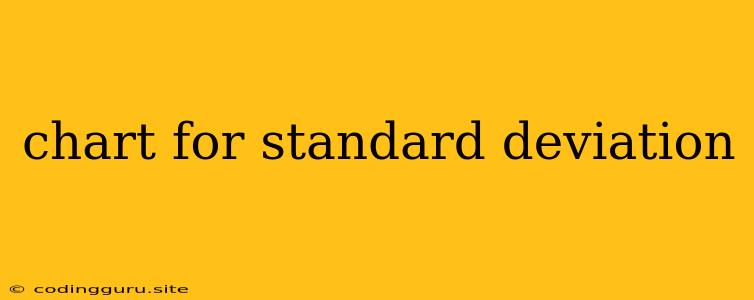Understanding and Visualizing Standard Deviation: Charts to the Rescue
Standard deviation is a crucial statistical measure that quantifies the amount of variation or dispersion within a set of data. It tells us how spread out the data points are around the mean. But how do we visualize and interpret this important concept? Enter the world of charts, powerful tools that help us grasp the essence of standard deviation and its implications.
Why Charts Matter for Standard Deviation
Standard deviation, while mathematically precise, can be abstract without a visual representation. Charts bridge this gap, offering a clear and intuitive understanding of:
- Data Spread: A chart visually reveals how tightly clustered or widely scattered the data points are around the mean.
- Outliers: Extreme values, known as outliers, become readily apparent, allowing for further investigation.
- Comparison: Charts allow for side-by-side comparisons of standard deviations across different datasets, highlighting relative variability.
- Trends: Changes in standard deviation over time can be visualized, indicating shifts in data consistency.
Types of Charts for Standard Deviation
Several chart types are adept at showcasing standard deviation:
1. Box Plot:
- Strengths: Box plots are excellent for visualizing the distribution of data and highlighting key percentiles (25th, 50th, 75th). The box itself represents the middle 50% of data, with the "whiskers" extending to the minimum and maximum values within a certain range (typically 1.5 times the interquartile range). Outliers are marked individually.
- How it shows standard deviation: The box plot doesn't directly display the standard deviation, but the box's width and the whisker lengths provide a good indication of the data's spread. A wider box or longer whiskers imply a larger standard deviation.
2. Histogram:
- Strengths: Histograms excel at visualizing the frequency distribution of data. They group data into bins, showing how many data points fall within each bin.
- How it shows standard deviation: The shape of the histogram reveals the data's spread. A wider histogram with a flatter peak suggests a higher standard deviation, whereas a narrower histogram with a sharper peak indicates a lower standard deviation.
3. Scatter Plot:
- Strengths: Scatter plots are useful for visualizing the relationship between two variables. They help determine if a relationship exists (e.g., positive, negative, or no correlation) and its strength.
- How it shows standard deviation: The spread of data points around the trend line (if one exists) reflects the standard deviation. A wider spread indicates a larger standard deviation.
4. Error Bars:
- Strengths: Error bars are typically added to bar charts, line charts, or scatter plots to represent the variability of the data. They visually depict the standard deviation or other measures of uncertainty.
- How it shows standard deviation: The length of the error bar directly represents the standard deviation. Longer error bars signify greater variability, while shorter error bars indicate less spread.
Choosing the Right Chart
The optimal chart type depends on the specific context and what insights you aim to convey. Consider the following:
- Type of data: Is your data categorical, numerical, or a combination?
- Number of variables: Are you visualizing one variable or multiple?
- Purpose: What insights are you seeking from the visualization?
- Audience: Who is the intended audience for the chart?
Examples
1. Box Plot Example: Consider analyzing the heights of students in a school. A box plot can clearly show the median height (50th percentile), the range of heights within the middle 50%, and any outliers (exceptionally tall or short students).
2. Histogram Example: If you're studying the distribution of salaries in a company, a histogram can reveal the salary range with the most employees, the frequency of salaries, and the spread of salaries overall.
3. Scatter Plot Example: In a study investigating the relationship between study hours and exam scores, a scatter plot can show the distribution of points and whether a positive correlation exists (i.e., more study hours generally result in higher scores).
4. Error Bars Example: Suppose you're tracking the average daily temperature over a year. Using a line chart with error bars can visually display the monthly average temperatures, along with the range of variation or uncertainty associated with each month's average.
Tips for Creating Effective Charts
- Clarity and Simplicity: Use clear labels, concise titles, and a clean aesthetic.
- Appropriate Scale: Ensure the axes are scaled appropriately to accurately represent the data.
- Color and Style: Use colors and styles strategically to enhance readability and highlight key points.
- Context: Provide context and any necessary background information to aid interpretation.
- Data Integrity: Always use accurate data and avoid misrepresenting information.
Conclusion
Understanding standard deviation is essential for analyzing data effectively. Charts play a pivotal role in translating abstract statistical concepts into visually compelling and readily interpretable insights. Whether you're analyzing data for research, business, or personal projects, utilizing appropriate chart types can illuminate patterns, reveal trends, and facilitate informed decision-making.
